I recently released a single-hand exercise for Red Chippers to practice their hand reading skills. This spot is not uncommon in live games and as such it’s useful to study it in more detail. So I took all of the responses, churned through the data, and came up with 5 massive take-aways that every live player can benefit from.
Since this exercise was solely focused on hand reading and understanding betting/checking frequencies of our opponent, let’s start by dissecting the preflop range that most players assigned. If you remember, the situation we explored was:
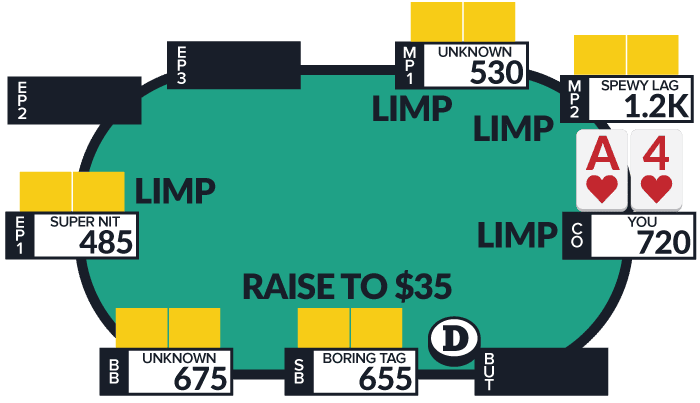
So what range of hands did players assign to a “boring TAG” who raised over multiple limpers from the small blind? Not shocking, there was a HUGE amount of variation. The tightest range assigned was KK+ and the widest was A2+, K5+, Q7+ TJ, 22+. That’s the difference between a 1% range of hands and a 40% range of hands. (It should be noted that I got rid of some outlier answers that were even wider than 40%.) But on average, the assigned preflop raising range for the SB was 7.8% of hands – which comes out to 88+/AJ+/KQ.
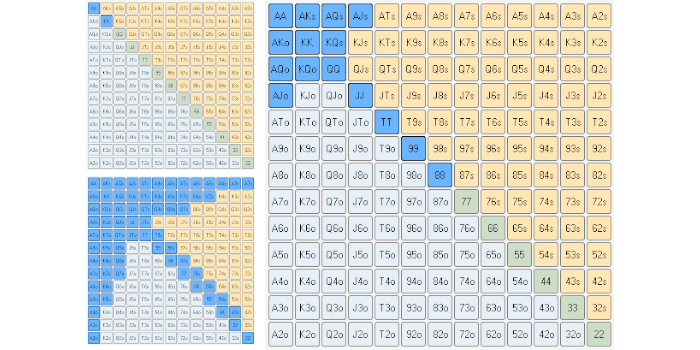
This brings us to takeaway #1…
POINT #1: %-FORM
At least 25% of the players who completed this exercise did not know the %-form for the preflop raising range they assigned. Even accounting for players who did this exercise from their phone without poker software, this is quite large. It’s important to know how %-form converts into real hole cards, and vice versa. If you assigned a range of TT+/AK and said that was 20% of hands, you will want to spend some time with Equilab to make sure you are more consistently +/- a few % in the future.
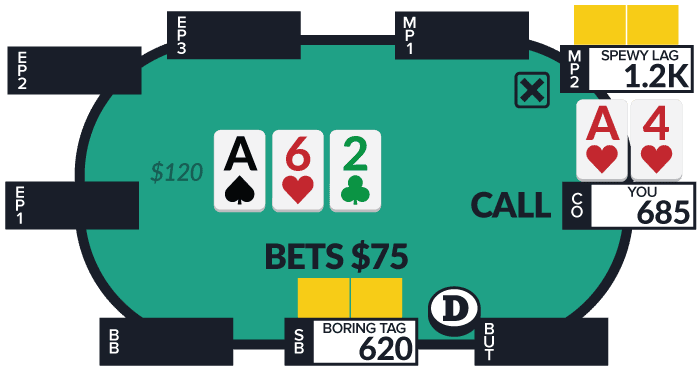
Going postflop, the average player thought the SB would CB the flop 51% of the time. This number may have been much larger if the flop didn’t go multi-way, keep that in mind. But after dissecting this frequency and then exploring the exact makeup of the ranges assigned, the average person assigned a very depolarized CB range. Very few players thought the SB would CB with KQ (even KQ with a BDFD), so the 51% range was very strong and was comprised of a lot of top pair — and of course, some 88-KK as well.
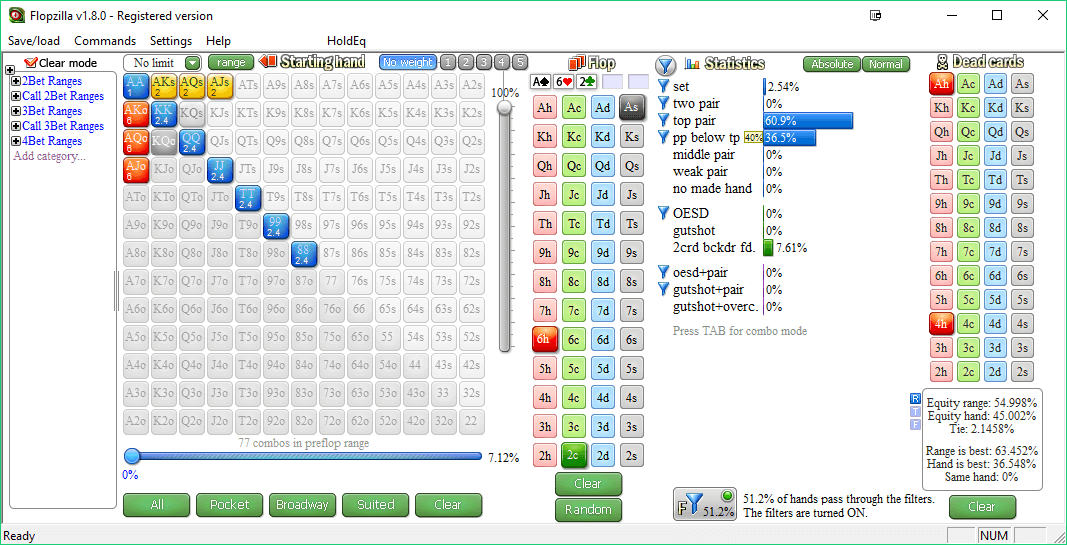
POINT #2: CB Checking Range
Most players only explore the exact action taken. But if we explore the opposite, in this case the other times where the SB checks the flop, we see something very important. Given that most players thought the SB would bet 100% of their top pairs and sets, that means that when the SB checks they either have KQ type hands or second-pair hands that dislike the Ace. If the SB had checked, what would you have done here? (You can pause and answer that if you’d like. ♥)
Onwards to the turn: The average player assigned a lowly 44% double-barrel range. Of course, this is going to be a very strong range of hands.
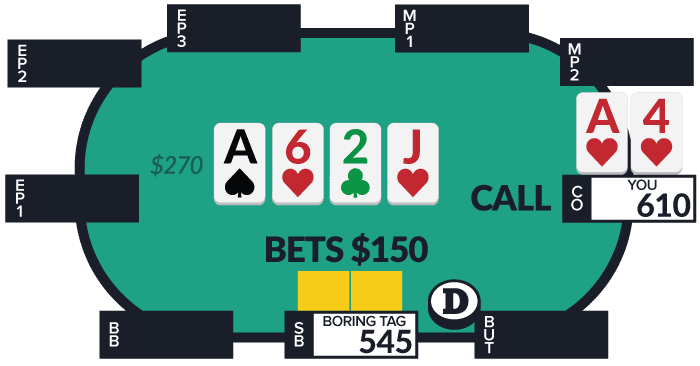
Most players put sets, AJ, and top pair in here and began to massively remove hands like QQ and TT from the SB’s range. And here’s the important thing: Because players assigned such a low turn bet frequency, that means that only a fraction of SB’s top pairs would get bet.
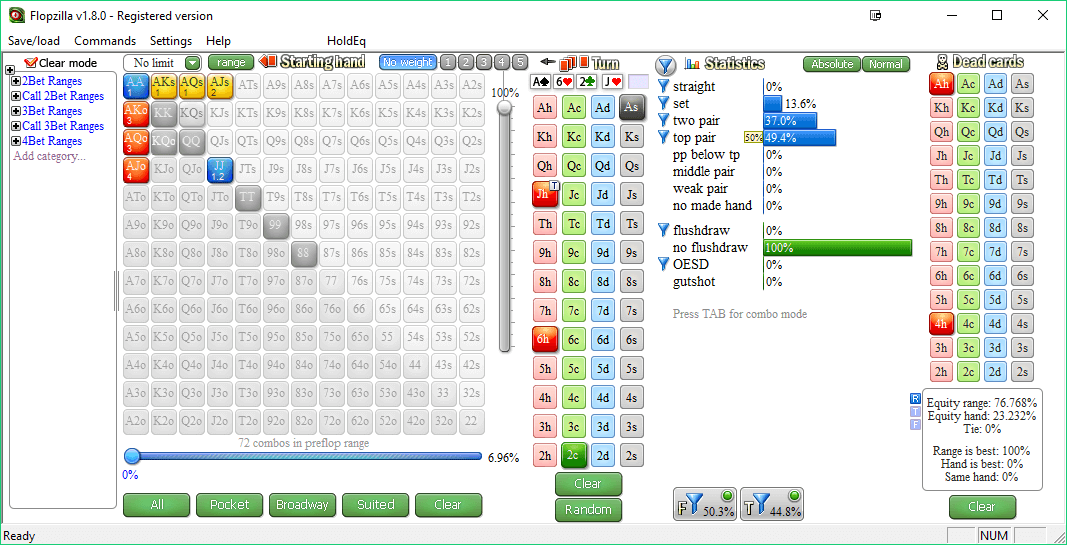
POINT #3: TURN TIGHTNESS
Given the strong CBing range and the very tight turn barreling range that was assigned on average, villain would only bet 50% of his top pairs on the turn. But is this really true? Is the SB really going to check the turn that often with hands like AK and AQ? Another big thing to notice is that as-assigned the turn betting range would be just 16 combos. 16 combos in a double barrel situation in a single-raised pot is very rare…so keep in mind how realistic this assessment likely is.
The big takeaway is that on average players are likely assigning too strong of a turn betting range – though this isn’t shocking when many players are too tight on the turn in their own range constructions.

Going into the river, the SB finally decides to check and it’s our action. On average players assigned a 35% checking range, which subsequently means they thought villain would fire 65% of the time with nuttish hands. Based upon the few number of combos that got bet on the turn, that means the river checking range was exactly half the combos of AK and AQ. How’s that for a super narrow range of hands?
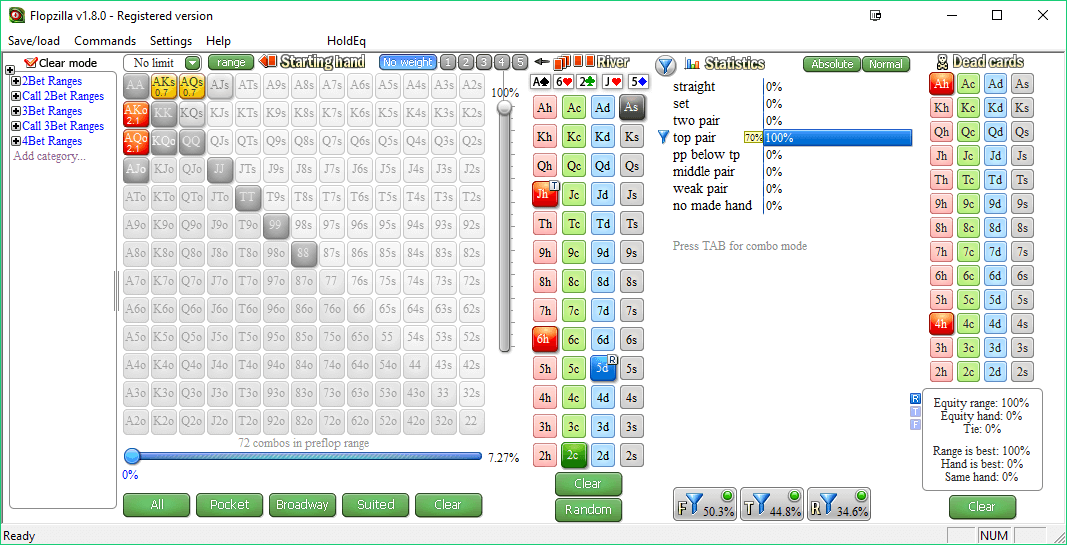
POINT #4: ADDING HANDS INCORRECTLY
Quite a few players added hands into the postflop ranges that were NOT in their preflop range. This is a major hand reading no-no. If the SB wouldn’t raise multiple limpers with A5s or 65s preflop, they couldn’t have improved to two pair on the river. I saw many players do this when assigning ranges on the turn and river especially. So if you do this when hand reading, just always ensure that you carry ranges from street to street, and never expand a range as action progresses.
Now there was one final question in this exercise, and that was: “As played, would you check behind, bet $250, or go all-in when checked to?” 74% of players said they would check behind on the river. And given the average checking range of AQ/AK that was assigned on the river, that’s not super shocking. Betting A4 into that range would yield about zero folds and would just end up setting money on fire.
But what most players forget is that we have a range here as well. Yes we hold A4s, but that’s just one part of our range. For a moment, let’s make the assumption that our range when we get to the river is A2s-A9s, 22, 66, the 4♥3♥, and a whiffed FD. If that’s the case, here is the GTO breakdown (thanks to GTORB) with our range vs our opponent’s range when he checks:
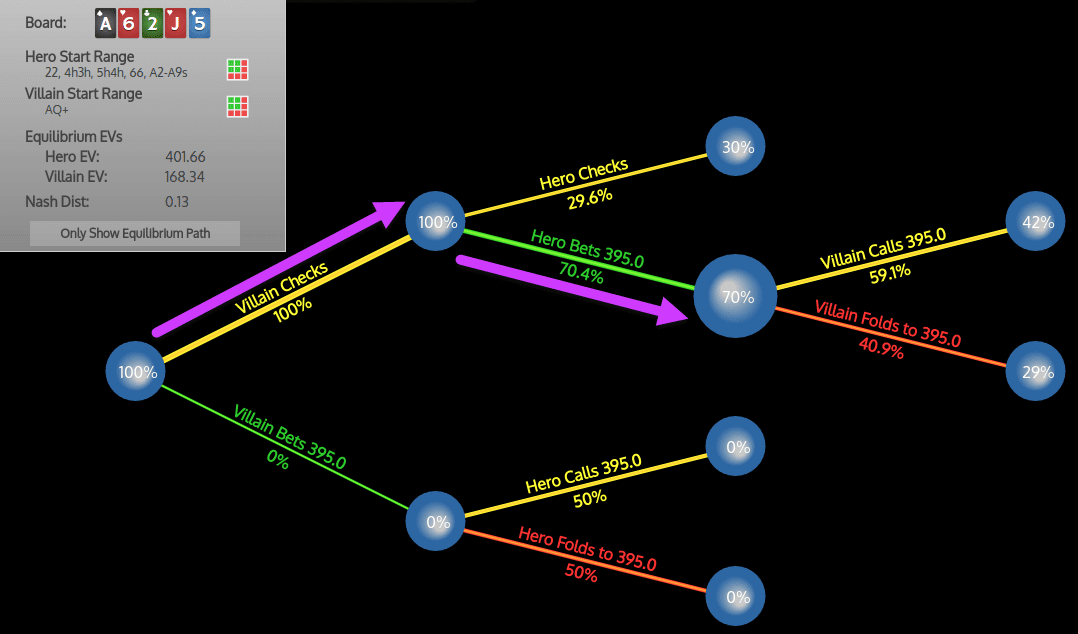
When we zoom in on our exact range we notice that we should be betting A4s 41% of the time and thus checking behind 59% of the time.
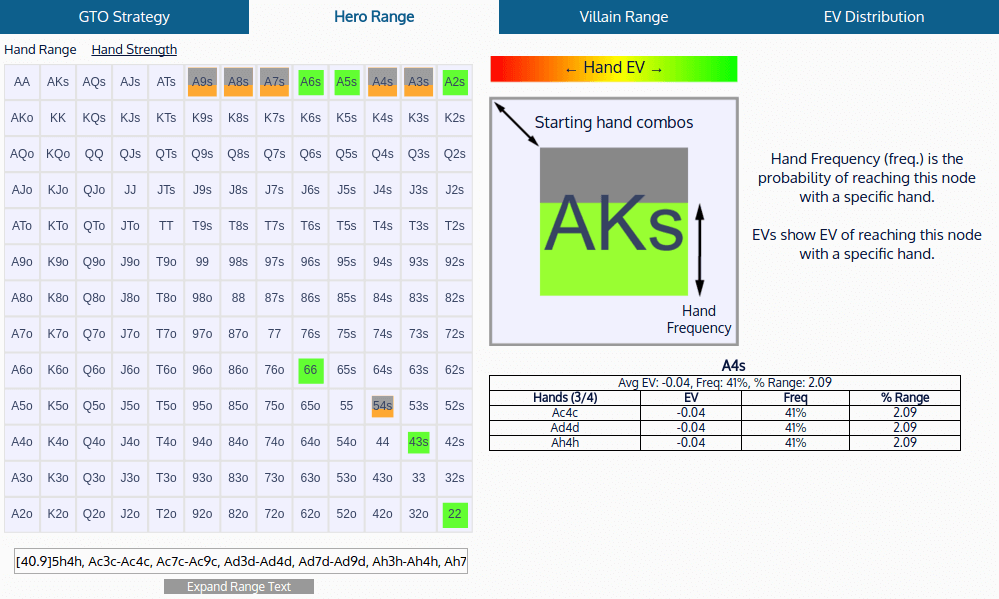
POINT #5: BETTING FREQUENCY
Most people wanted to just check-behind – and the average reasoning in the forum had to do with the SB having a very strong range when they checked to us on the river. While that’s true based upon the average assigned ranges — and just firing A4 into AQ+ in a zero-FE vacuum would set money on fire — we have to remember that when our opponent can hand read at all, we need to consider our own range. And at that point having an understanding of GTO gives us a great guiding light.
I have a sneaking suspicion that this is one of those spots where players got close to the right answer…but for the wrong reason.
If nothing else, this kind of exercise is great for practicing your hand reading. Be sure to look at the averages to see what the average poker player assigns at each step of the way. It will help you to see if your assumptions are too tight, too loose, or right on track. And remember: When turning postflop frequencies into real ranges, you need to use your strategy-mind to really think about the way a player would shape their ranges. A player betting the flop 51% of the time doesn’t tell you much — unless you factor in how much of that betting range is strong vs. marginal vs. weak.
So keep practicing, keep analyzing hands like this, and you’ll keep finding leaks in your opponents’ strategies. It may seem awkward at first, but soon you’ll see their ranges more clearly and it will become a ton easier to identify new spots to bluff or value bet thinner. If you’re looking for a ton of exercises that you can jump into right now, pick up your copy of the Hand Reading Workbook. It contains 40 exercises that will help you analyze your own ranges, your opponent’s ranges, and even range-vs-range situations. Complete just 1 exercise per day and see how much easier it is to hand reading in a month’s time!

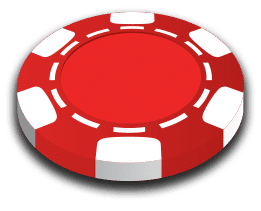
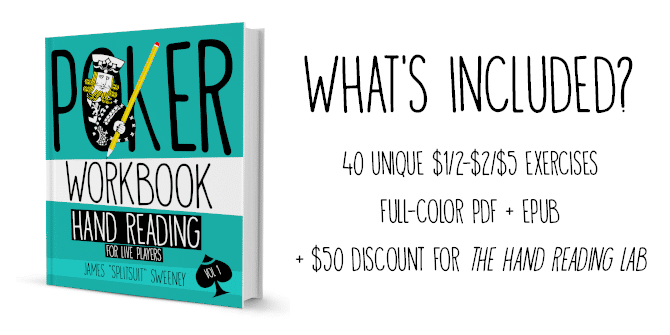
In live $2-5 are we really to the point where we need to be making GTO decisions on river bets? Table change please.
It’s not that we have to use a GTO strategy on the river – but it’s at least powerful to know what the GTO output looks like.
That is a super strong article with a ton of information to take away. Excellent job James. I am sure the book will be awesome as well. Thanks.
Thanks Steve!
Thank you very much. This was a useful way to think through and I look forward to your work book if you have more of these kinds of exercises.
It is nice to know I did not make terrible blunders in my range estimates (like including hands on the flop that couldn’t be there preflop). I do see that my range estimate was slightly wider than average about 11%, 45% of that on the flop (right on average), and a massive 70% on the turn.
So I went all in. My experience is that I win here against these kinds of tight boring players at least 4%0 of the time. I think this is true at my $1-$2, $1-$3 live cash games. It might even work better $2-$5.
At the $2-5 games that I have been observing, and taking notes on, when I go to the casino the tight -players fold, fold, fold, when somebody bets high or goes all-in against them on the river. Often they snap fold. Sometimes they tank, because they are suffering from buyers regret, not because they believe in their hand. (I imagine them thinking, “I bought this pot and now this has happened!”)
But depending on the board texture I might have reraised big on the turn anyway and committed to a bluff.
Then again I might not have been in this hand in the first place unless this move was somewhere in my plan. If I decided to be in the hand though I probably would have planned at the flop to a big turn or river bet if “TightBoring” player showed weakness. In live play, I have had good results with tight boring players, with this kind of bluff. (I’m assuming top-pair and low-kicker is a bluff.)
That might be my big mistake.
You’re very welcome Jerry – and yes, the upcoming workbook is full of exercises like this =)
Can’t wait. Excellent Idea. After completing the hand reading lab and reviewing some of the hand examples I was hungry for more examples. I’m excited to see the format. About the A4 challenge, when you analyze hero’s range on the river, from my analysis its not such a clear check. Of course when you look at hero’s actual holding things change.
Thanks Tom! Re the river: it all depends what villain would do. If they think about your range and may fold some % of the time, jamming can make a lot of sense. But if 100% of their river check range is also check/calling – we can beat their frequency by making sure our river jamming range beats AQ.
James,
Am I understanding the data correctly?
If we run the same example using a more aggressive Villain with 20% PFR
(AA-22,AKo-ATo,KQo-KTo,QJo-QTo,JTo,AKs-ATs,KQs-KTs,QJs-QTs,JTs-J9s,T9s-T8s,98s,87s,76s,65s,54s)
Villain CB 60.5% on the flop with Weak Pairs+, Gutshots, 2CBDFD.
Turn bet 59% with Weak Pairs+, FD, Gutshots.
On the river If Villain checks with Weak Pairs-TP. Equites are 52% villain vs 48% hero.
24 combos of hands beat us, 22 combos of hands we beat.
BE on a shove is 40% 395/395+570 plus 48% equity when called.
Using the fold equity calculator, shove is profitable. The more air Villain has in any street and in his checking range
on the river the better for hero.
tfazio,
His air on the river doesn’t matter. He will just fold. What matters for our shove is that he has to call with worse 50% of the time otherwise we should simply check behind. And that means 50% of his calling range, not just 50% of his entire range. That’s just river value betting 101.
Unless we expect him to fold better, then we’re bluffing and need to use the red chip fold equity calculator. But IMO given the range of better hands he arrives at the river with, he’s not folding much if any.
I think the turn tightness may have come from the way people are used to looking at turn Cbet percentages. The questions asks what % of his flop CB range is that? I think a lot of people would misread this and just assign the % of their preflop range rather then the % of their Cbet range. This would give lots of 40%-50% answers that maybe should have been 80%-90%.
It’s possible – but I did multiple checks and it seems on pace given people did assign the second pairs like TT+ for the flop CB but NOT for the double barrel.
James,
its a cool thought experiment to think of hand reading like this, but taking a consensus average percentage has real risks of ‘assumption’. The last poster pointing out the “% of starting range, or % or Flop Cbets” issue, and more importantly, the polarized versus depolarized issue. Super nits are not usually polarized, but we should at least acknowlege that not all 20% ranges look alike.
The middle posters that point out that super nits fold to shoves more often than they should is also a very valid point. If we are assigning a range for the opponent to interpret from our play, should we not also at least include some fold equity based on reads? or not? maybe a super nit gets married to top pair (we have all seen the type who never folds AA no matter what).
nice post though
Thanks Steve! Of course, I would never say that all 20% ranges look alike. But this is also why I not only asked people to share the range in %-form but also in written form. I did a bunch of checks to see how people were shaping the ranges they assigned and most were very depolarized with a severe cusp on the turn and river.
Great information and probably applicable for most Poker rooms outside of Florida. Why is Florida different? Because most Poker rooms have huge amounts of competition in Florida so they are always giving away high hand promotions every day. For example at Daytona on Saturdays they have 1,000 dollar 1/2 hour high hands; so any pair plus all suited connectors will call almost any bet trying to hit a high hand. Both hole cards have to play.
Some rooms only one hole card has to play. I have seen so many Royal and Str8 Flushes at these rooms it is amazing. I won over 6K last year on high hands alone. If the flop comes down highly coordinated just fold, you are most likely beat. Two pair is minimum to call any bet. The moral of the story is hand reading is out the window until after the flop. It is almost a waste of time trying to put people on ranges because their ranges are so wide. At rooms with only one hole card needing to be in play for a high hand people will call with damn near any two cards.
Just because ranges are really wide doesn’t mean we abandon hand reading all together. It just means that you start by assigning a really wide range and then go from there =)
Am I misreading the GTORB output? You said “When we zoom in on our exact range we notice that we should be betting A4s 41% of the time and thus checking behind 59% of the time.”. The output seems show hero betting 70% of the time villian folding to that bet 41% of the time. Am I misreading this?
Hey John. The top part with the flowchart shows hero’s entire betting range. The image underneath explores each hand within that range and you’ll notice in the small table (under the big AKs) shows A4 at a 41% frequency.
I’m not sure bombing the river is not GTO optimal here. 4h3h is totally within our range here, and we have a blocker.
I mean, if you don’t shove the river here, what do you do when you do have 4h3h ? If you only shove when you have the nuts, you’re losing money in the long run.
GTORB factored all of that in =)